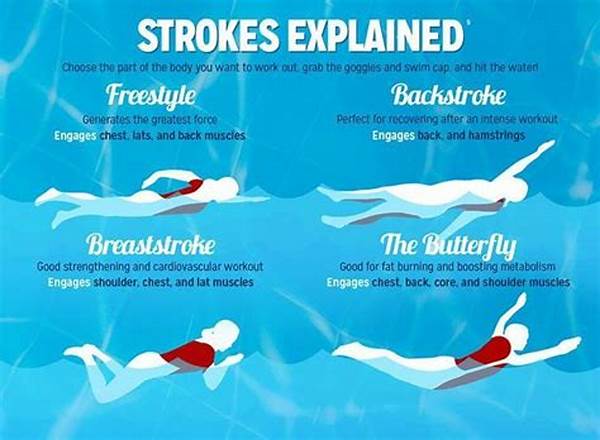Key Swimming Strokes And Their Competitive Advantages

In the dynamic world of competitive swimming, understanding the key swimming strokes and their competitive advantages can be quite literally a game-changer. From the moment a swimmer dives off the starting block, they engage in a race against time, against opponents, and perhaps against their own previous records. For those passionate about the sport, the allure lies not only in the competition but in mastering the nuanced techniques that distinguish the elite from the ordinary. Whether you’re a seasoned swimmer, a budding athlete dreaming of Olympic glory, or simply fascinated by the mechanics of human movement in water, the four primary strokes—freestyle, backstroke, breaststroke, and butterfly—hold secrets of speed, efficiency, and grace waiting to be unraveled.
Read More : The Role Of Speed in Martial Arts
Each swim stroke comes with its own unique history, technique, and set of advantages and challenges. Take freestyle, for instance, often considered the fastest and most efficient stroke; it requires continuous arm motion and a flutter kick that propels swimmers through the water at impressive speeds. On the flip side, the breaststroke, with its more methodical pace, is cherished for its reliance on timing and powerful leg kicks. Understanding the characteristics of each stroke reveals how swimmers leverage their strengths and compensate for their weaknesses in the quest for excellence. It’s like a chess game played in fluid motion, where every stroke can dictate the race’s outcome.
Moreover, the world of competitive swimming isn’t just cutthroat; it’s a realm filled with camaraderie, inspiration, and lessons that transcend the pool. The commitment of early morning training sessions, the thrill of competition, and the relentless pursuit of personal bests resonate deeply with universal themes of perseverance and passion. For spectators, watching a swim meet can be akin to witnessing a carefully choreographed water ballet, underscored by intensity and drive. These elements create a rich tapestry that combines human capability and the science of movement, weaving unforgettable stories both in and out of the water.
But before plunging into the finer details of these strokes, it’s essential to embark on a broader exploration that underscores their significance. So grab your goggles and prepare to dive deep into the fascinating realm of swimming technique with us, uncovering just why these strokes are the backbone of competitive swimming and what competitive edges they can provide you. Whether you’re on the deck watching or in the lanes competing, the world of key swimming strokes and their competitive advantages is as enthralling as it is challenging—and it’s time to unravel its many layers.
Understanding the Competitive Edge of Swimming Strokes
Derived from the elegant intersection of physics and human anatomy, swimming strokes are crafted not just for movement, but for mastery. The myriad nuances between different strokes allow swimmers to harness their physical capabilities to excel in competitions. Let’s examine the purpose and distinct characteristics that make each stroke not only unique but strategically significant in competitive arenas.
Freestyle offers swimmers an incredible edge in speed due to its hydrodynamic efficiency. This stroke is characterized by alternate arm strokes and a steady flutter kick, allowing swimmers to cover vast distances at a quick pace. The streamlined body position reduces drag, making freestyle the go-to stroke in long-distance races. The competitive advantage of freestyle lies in its versatility and speed—any swimmer can tailor it to maximize their personal strengths, whether they’re powering through a short sprint or maintaining stamina for endurance events.
Conversely, backstroke provides a unique view of competition—literally. Swimmers race on their backs, utilizing an alternating arm action coupled with a flutter kick. While surface breathing offers a distinct advantage, backstroke presents challenges in navigation and requires excellent spatial awareness. A skilled backstroke competitor leverages rhythm and coordination to maintain speed and efficiently turn at the pool’s end. Backstroke’s competitive advantage lies in its strategic breathing management and counter-clockwise kicking rhythm.
Breaststroke, with its powerful kick and sleek glide, demands precision in timing more than any other stroke. It’s the slowest of the four, but its finely tuned mechanics rely on a dolphin-like kick action, under-the-water arm pulls, and a streamlined body position during glides. Competitors who master the breaststroke often relish in strategic races, excelling in events that call for tactical execution rather than sheer speed. Its competitive advantage stems from its dynamic balance between quick powerful bursts and strategic recovery phases.
Butterfly is renowned for its graceful yet challenging technique—the dramatic arm pull, the dynamic dolphin kick, and the breathtaking leap through the water’s surface. This stroke requires tremendous upper body strength and excellent rhythm to execute seamlessly. It’s not just strength but precision timing that gives swimmers a flying edge. Despite its demanding nature, butterfly’s competitive advantage offers phenomenal potential for show-stopping finishes when executed correctly, potentially turning the tide in any mid-length race.
These strokes each hold the key to unlocking competitive advantages that can significantly influence race outcomes. Embracing the nuances and strategies unique to each gives swimmers a crucial edge in competition.
Crafting the Path to Swim Success
Knowing how to swim is one thing; mastering the key swimming strokes and their competitive advantages is another realm entirely. It allows you to transcend basic survival skills and delve into a world of athletic proficiency and water-based artistry. While each swim stroke requires a fair share of dedication, understanding their competitive advantages offers a roadmap to navigating races more strategically.
The action plan for any aspiring swimmer starts with learning. Research and education form the cornerstone of mastering swimming techniques. Swimmers must study everything from body positioning to breath coordination. It’s beneficial to watch professionals, study their strokes, and even attend workshops that delve into the biomechanics of swimming.
Next, instructors play a pivotal role in guiding swimmers through the intricate choreography of each stroke. Lessons from experienced coaches can replace trial and error with actionable insights, allowing swimmers to hone their skills efficiently. Whether an athlete prefers group lessons or one-on-one instruction, personalized feedback is invaluable for improving technique and optimizing performance.
Meanwhile, practice remains the hallmark of progress. Diligently incorporating varied training drills can assist swimmers in mastering specific skills, such as perfecting hand entry angles in freestyle or timing the kick in breaststroke. It’s important for swimmers to balance their practice sessions, focusing not just on technique but also endurance, speed, and strategy.
Finally, embracing technology and innovation can further unlock potential. Analyzing race times, utilizing wearable tech for real-time feedback, and engaging with virtual swims can introduce new dimensions to training. These enhancement tools offer insights that can sharpen competitive awareness, encourage data-driven progress, and transform aspirations into shark-like agility.
By integrating these elements, swimmers can position themselves to maximize the benefits that come from understanding key swimming strokes and their competitive advantages. Charting a course with informed decisions, meticulous practice, and strategic planning isn’t just about victory in races; it’s about realizing one’s full potential in the water.
Read More : Physical Training For Sprinting And Table Tennis
Ideal Techniques for Key Swimming Strokes
The journey to mastering key swimming strokes and their competitive advantages is not only a scientific venture but an artistic pursuit that blends determination with advanced techniques. From the elegance of the butterfly to the streamlined speed of freestyle, each stroke brings its own set of challenges and rewards.
Swimming is an interplay of power, efficiency, and grace. Freestyle helps in maximizing speed and cutting through the water, whereas backstroke emphasizes smooth backward propulsion, which is trickier but rewarding. Breaststroke offers a slower, methodical pace, favoring swimmers with excellent timing and a strategic approach to racing. Butterfly requires seamless power and timing, presenting a high-risk, high-reward opportunity in competition.
Successful swimmers dwell on the merits of consistency. Those who invest in learning and refining their skills witness exponential growth. Swimming isn’t just about physical prowess; it’s about cultivating a mental edge to read races, predict opponents, and stay ahead strategically.
Implement these strategic tips for optimal results, combining them with tailored training routines to address specific needs. Whether you’re aiming to dominate local swimming competitions or aspiring to Olympic heights, understanding key swimming strokes and their competitive advantages will carve your path to competitive swimming success.
Creating the Ripple Effect in Competitive Swimming
Swimmers today have the unique opportunity to explore the fascinating essentials of key swimming strokes and their competitive advantages. With the right blend of passion, technique, and strategy, athletes can make waves both literally and figuratively. This journey requires dedication, but with it comes the promise of reaching new milestones and setting unparalleled race records.
For emerging athletes, swimming lessons offer a fundamental gateway into the sport. Early exposure to key swimming techniques fosters a foundation on which swimmers can build their competitive skills. This progression often begins with familiarizing oneself with the water, nourishing comfort, and learning the basic strokes. For many, it’s a gradual love affair with the water that grows as they move from perfecting basics to mastering competitive nuances.
As swimmers progress, the role of competitive swimming clubs becomes invaluable. These clubs present tailored resources, expertise, and peer motivation essential for breaking barriers. The athletes’ journey is not a solitary one—the camaraderie within these communities sustains motivation, somersaulting ordinary swimmers into extraordinary racers.
For many elite swimmers, the climb to excellence incorporates digital innovation. From specialized training apps to state-of-the-art performance analytics, technology’s contribution can’t be overstated. It transforms swim practice from routine to riveting, visualizing one’s journey from novice to champion in gigabytes.
Swimming excellence also serves a motive beyond competitive glory. There’s genuine fulfillment in seeing one’s hard work bourgeon into achievements. The tangible rewards of winning medals or shattering personal bests are only part of the propelling reason; the most rewarding feat is the silent satisfaction of a dream pursued with diligence.
With that determination in your stroke and fervor in your heart, immerse yourself in the understanding of key swimming strokes and their competitive advantages. Because after all, the water is just what you make of it—a conduit to unrivaled challenges and victories waiting to be conquered.
Six Critical Tips for Competitive Advantage in Swimming
Achieving progress in key swimming strokes and their competitive advantages necessitates a mix of dedication, strategy, and on-the-ground tips. Here’s a beginner’s guide to prime yourself for success:
Mastering the art of swimming requires a cohesive understanding of both the physics of movement and the psychology of performance excellence. Integrating analytical skills with passionate practice sets swimmers on an unshakable path toward competitive mastery.



